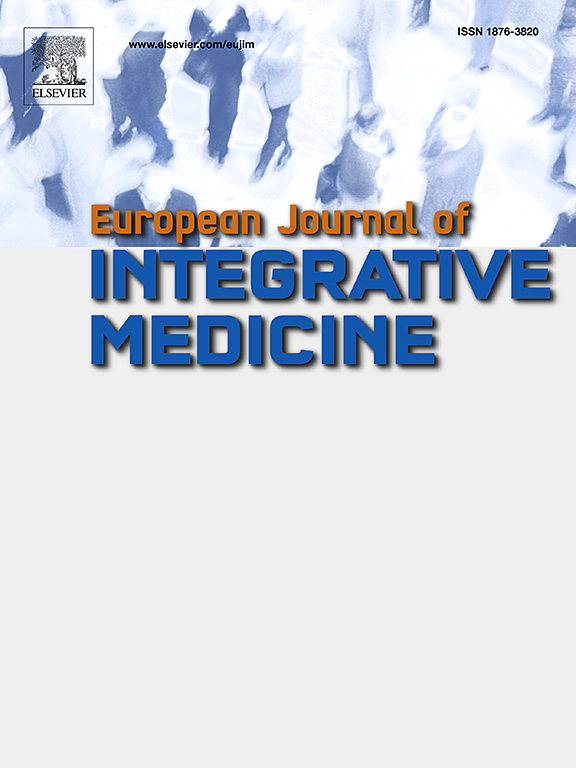Efficacy, safety, and pharmacological mechanism of Suxiao Jiuxin Pill in acute coronary syndrome: A systematic review and network pharmacology analysis
IF 1.9
4区 医学
Q3 INTEGRATIVE & COMPLEMENTARY MEDICINE
引用次数: 0
Abstract
Introduction
Suxiao Jiuxin Pill (SJP), a patented Chinese medicine, is used to treat various cardiovascular diseases, including acute coronary syndrome (ACS). Nonetheless, substantial evidence validating the efficacy and safety of SJP, as well as elucidating its underlying mechanisms in ACS treatment, is lacking. In this study, a systematic review and network pharmacology approach were employed to evaluate the efficacy and safety of combining SJP with conventional treatment (CT) for ACS and to explore the potential mechanisms.
Methods
A systematic search of eight electronic databases was conducted to retrieve relevant randomized controlled trials (RCTs) which evaluated the efficacy and safety of SJP combined with CT for treating ACS. The Cochrane risk-of-bias tool for RCTs version 2.0 was used to assess the risk of bias. The fixed-effects model or the random-effects model was determined based on the significance of the statistical heterogeneity and clinical heterogeneity. Risk ratios and mean differences were calculated for binary variables and continuous variables, respectively, based on a 95 % confidence interval. Finally, network pharmacology analysis was used to explore the underlying mechanisms of action of SJP in ACS treatment.
Results
A total of 39 RCTs involving 4265 patients were included. The intervention group showed significant improvements, including a lower incidence of myocardial infarction, left heart failure, and sudden death, compared to the control group. The intervention group also demonstrated enhanced clinical efficacy, improved electrocardiogram results, fewer angina attacks, and shorter duration of angina. No significant differences in the incidence of adverse events were found between the intervention and control groups. Network pharmacology identified ferulic acid, caffeic acid, and scopoletin as the active ingredients responsible for the observed therapeutic effects of SJP. Additionally, potential therapeutic targets such as GSK3B, PRKCA, and EGFR, as well as other pathways related to the HIF-1, IL-17, and TNF signaling pathways, were identified as potential mechanisms regulated by SJP.
Conclusion
This study indicates that a combination therapy of SJP and CT may provide benefits for patients with ACS by reducing cardiovascular events, improving myocardial ischemia, and alleviating cardiac symptoms with favorable safety. These findings also suggest that the effects of SJP on ACS involve a multi-target, multi-component, and multi-pathway mechanism.

素消九心丸治疗急性冠脉综合征的疗效、安全性及药理机制:系统评价及网络药理学分析
速效九心丸(SJP)是一种中药专利,用于治疗各种心血管疾病,包括急性冠脉综合征(ACS)。尽管如此,尚缺乏足够的证据来证实SJP的有效性和安全性,以及阐明其在ACS治疗中的潜在机制。本研究采用系统评价和网络药理学方法评价SJP联合常规治疗(CT)治疗ACS的疗效和安全性,并探讨其潜在机制。方法系统检索8个电子数据库,检索评价SJP联合CT治疗ACS疗效和安全性的相关随机对照试验(rct)。采用Cochrane rct风险偏倚工具2.0版评估偏倚风险。根据统计异质性和临床异质性的显著性确定固定效应模型或随机效应模型。基于95%的置信区间,分别计算二元变量和连续变量的风险比和平均差异。最后,通过网络药理学分析探讨SJP治疗ACS的作用机制。结果共纳入39项随机对照试验,共4265例患者。与对照组相比,干预组表现出显著的改善,包括心肌梗死、左心衰竭和猝死的发生率较低。干预组临床疗效增强,心电图结果改善,心绞痛发作次数减少,心绞痛持续时间缩短。干预组和对照组的不良事件发生率无显著差异。网络药理学鉴定阿魏酸、咖啡酸和东莨菪碱是导致SJP治疗效果的有效成分。此外,潜在的治疗靶点,如GSK3B、PRKCA和EGFR,以及与HIF-1、IL-17和TNF信号通路相关的其他途径,被确定为SJP调节的潜在机制。结论SJP联合CT治疗ACS患者可减少心血管事件,改善心肌缺血,缓解心脏症状,且安全性较好。这些发现还表明,SJP对ACS的影响涉及多靶点、多组分和多途径机制。
本文章由计算机程序翻译,如有差异,请以英文原文为准。
求助全文
约1分钟内获得全文
求助全文
来源期刊

European Journal of Integrative Medicine
INTEGRATIVE & COMPLEMENTARY MEDICINE-
CiteScore
4.70
自引率
4.00%
发文量
102
审稿时长
33 days
期刊介绍:
The European Journal of Integrative Medicine (EuJIM) considers manuscripts from a wide range of complementary and integrative health care disciplines, with a particular focus on whole systems approaches, public health, self management and traditional medical systems. The journal strives to connect conventional medicine and evidence based complementary medicine. We encourage submissions reporting research with relevance for integrative clinical practice and interprofessional education.
EuJIM aims to be of interest to both conventional and integrative audiences, including healthcare practitioners, researchers, health care organisations, educationalists, and all those who seek objective and critical information on integrative medicine. To achieve this aim EuJIM provides an innovative international and interdisciplinary platform linking researchers and clinicians.
The journal focuses primarily on original research articles including systematic reviews, randomized controlled trials, other clinical studies, qualitative, observational and epidemiological studies. In addition we welcome short reviews, opinion articles and contributions relating to health services and policy, health economics and psychology.
 求助内容:
求助内容: 应助结果提醒方式:
应助结果提醒方式:


